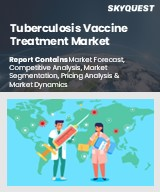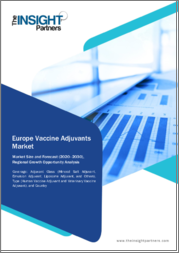
|
시장보고서
상품코드
1772699
결핵 백신 치료 시장 규모, 점유율, 성장 분석, 백신 유형별, 치료 유형별, 최종사용자별, 연령층별, 지역별 - 산업 예측(2025-2032년)Tuberculosis Vaccine Treatment Market Size, Share, and Growth Analysis, By Vaccine Type (BCG, Recombinant), By Treatment Type (Preventive, Therapeutic), By End-User, By Age Group, By Region - Industry Forecast 2025-2032 |
||||||
결핵 백신 치료 세계 시장 규모는 2023년 5억 달러, 2024년 5억 2,000만 달러에서 2032년에는 7억 2,000만 달러에 이르고, 예측 기간(2025-2032년) CAGR은 4.1%를 나타낼 전망입니다.
결핵 백신 치료 시장은 결핵 유병률 증가와 결핵에 대한 인식이 높아짐에 따라 크게 성장하고 있습니다. 환자 수가 증가함에 따라 효과적인 예방법, 특히 백신에 대한 수요가 증가하고 있습니다. 교육 이니셔티브와 정부 주도의 공중보건 캠페인은 결핵에 대한 인식을 높이고 결핵과 관련된 위험과 예방접종의 이점을 강조하는 데 있어 매우 중요합니다. 또한, 의료 인프라의 발전으로 진단 능력과 백신 접종 서비스에 대한 접근성이 향상되어 결핵의 조기 발견과 개입이 쉬워지고 있습니다. 이러한 요인들이 결합되어 결핵 백신 치료는 전 세계 보건 상황에서 매우 중요한 요소로 자리 잡고 있으며, 시장 수요를 주도하고 있습니다.
목차
서론
- 조사 목적
- 조사 범위
- 정의
조사 방법
- 정보 조달
- 2차와 1차 데이터 방법
- 시장 규모 예측
- 시장 전제조건과 제한
주요 요약
- 세계 시장 전망
- 공급과 수요 동향 분석
- 부문별 기회 분석
시장 역학과 전망
- 시장 개요
- 시장 규모
- 시장 역학
- 성장 촉진요인과 기회
- 성장 억제요인과 과제
- Porter의 Five Forces 분석
주요 시장 인사이트
- 중요 성공 요인
- 경쟁 정도
- 주요 투자 기회
- 시장 생태계
- 시장의 매력 지수(2024년)
- PESTEL 분석
- 거시경제 지표
- 밸류체인 분석
- 사례 연구
결핵 백신 치료 시장 규모 : 백신 유형별&CAGR(2025-2032)
- 시장 개요
- BCG
- 재조합
- 생약독화
- 불활성화
결핵 백신 치료 시장 규모 : 치료 유형별&CAGR(2025-2032)
- 시장 개요
- 예방
- 치료
결핵 백신 치료 시장 규모 : 최종사용자별&CAGR(2025-2032)
- 시장 개요
- 병원
- 클리닉
- 연구기관
- 기타
결핵 백신 치료 시장 규모 : 연령층별&CAGR(2025-2032)
- 시장 개요
- 소아
- 성인
결핵 백신 치료 시장 규모 : 지역별&CAGR(2025-2032)
- 북미
- 미국
- 캐나다
- 유럽
- 독일
- 스페인
- 프랑스
- 영국
- 이탈리아
- 기타 유럽
- 아시아태평양
- 중국
- 인도
- 일본
- 한국
- 기타 아시아태평양
- 라틴아메리카
- 브라질
- 기타 라틴아메리카
- 중동 및 아프리카
- GCC 국가
- 남아프리카공화국
- 기타 중동 및 아프리카
경쟁 정보
- 주요 5개사 비교
- 주요 기업의 시장 포지셔닝(2024년)
- 주요 시장 기업이 채택한 전략
- 최근 시장 동향
- 기업의 시장 점유율 분석(2024년)
- 주요 기업 개요
- 기업 상세
- 제품 포트폴리오 분석
- 기업 부문별 점유율 분석
- 매출 전년대비 비교(2022-2024년)
주요 기업 개요
- Xykon
- Merck and Co
- Pfizer
- Aeras
- Antabio
- KNCV Tuberculosis Foundation
- Inovio Pharmaceuticals
- Bavarian Nordic
- Bill and Melinda Gates Foundation
- Vaxart
- Serum Institute of India
- Emergent BioSolutions
- GlaxoSmithKline
결론과 제안
LSH 25.07.23Global Tuberculosis Vaccine Treatment Market size was valued at USD 0.5 billion in 2023 and is poised to grow from USD 0.52 billion in 2024 to USD 0.72 billion by 2032, growing at a CAGR of 4.1% during the forecast period (2025-2032).
The tuberculosis vaccine treatment market is experiencing significant growth due to the increasing prevalence of tuberculosis and the heightened awareness surrounding the disease. As more cases emerge, the demand for effective prevention methods, particularly vaccines, is intensifying. Educational initiatives and government-led public health campaigns are pivotal in raising awareness about tuberculosis, emphasizing the risks associated with it and the benefits of vaccination. Furthermore, advancements in healthcare infrastructure are improving diagnostic capabilities and the accessibility of vaccination services, facilitating early detection and intervention for tuberculosis. Collectively, these factors are driving robust demand in the market, positioning tuberculosis vaccine treatments as a crucial element in the global health landscape.
Top-down and bottom-up approaches were used to estimate and validate the size of the Global Tuberculosis Vaccine Treatment market and to estimate the size of various other dependent submarkets. The research methodology used to estimate the market size includes the following details: The key players in the market were identified through secondary research, and their market shares in the respective regions were determined through primary and secondary research. This entire procedure includes the study of the annual and financial reports of the top market players and extensive interviews for key insights from industry leaders such as CEOs, VPs, directors, and marketing executives. All percentage shares split, and breakdowns were determined using secondary sources and verified through Primary sources. All possible parameters that affect the markets covered in this research study have been accounted for, viewed in extensive detail, verified through primary research, and analyzed to get the final quantitative and qualitative data.
Global Tuberculosis Vaccine Treatment Market Segments Analysis
Global Tuberculosis Vaccine Treatment Market is segmented by Vaccine Type, Treatment Type, End-User, Age Group and region. Based on Vaccine Type, the market is segmented into BCG, Recombinant, Live Attenuated and Inactivated. Based on Treatment Type, the market is segmented into Preventive and Therapeutic. Based on End-User, the market is segmented into Hospitals, Clinics, Research Institutes and Others. Based on Age Group, the market is segmented into Pediatric and Adult. Based on region, the market is segmented into North America, Europe, Asia Pacific, Latin America and Middle East & Africa.
Driver of the Global Tuberculosis Vaccine Treatment Market
The rise in awareness surrounding tuberculosis treatments plays a crucial role in driving the global tuberculosis vaccine treatment market. As public knowledge of TB risks and the significance of vaccination grows, it fosters greater acceptance and demand for vaccines. Health education initiatives and outreach efforts contribute to a better understanding of prevention methods, encouraging timely immunization. This heightened awareness supports government initiatives and financial backing, ultimately leading to improved vaccine coverage. Such developments are particularly vital in regions heavily burdened by TB, where effective control measures are essential to combat the disease and boost the tuberculosis vaccine market's growth.
Restraints in the Global Tuberculosis Vaccine Treatment Market
The Global Tuberculosis Vaccine Treatment market faces significant challenges due to the limited effectiveness of the BCG vaccine in preventing pulmonary tuberculosis, particularly in adolescents and adults. While the BCG vaccine is effective against severe forms of TB in young children, its efficacy diminishes with age and offers inconsistent protection in the adult population. This reduced effectiveness leads to a decline in confidence and demand for the vaccine, highlighting a crucial need for innovative and enhanced vaccine options. Consequently, this limitation hampers market growth and complicates global efforts to control and manage tuberculosis effectively.
Market Trends of the Global Tuberculosis Vaccine Treatment Market
The global tuberculosis vaccine treatment market is witnessing a transformative trend centered around the development of novel vaccines that aim to address the limitations of the traditional BCG vaccine. As researchers explore innovative methodologies-including live attenuated, subunit, viral-vectored, and mRNA vaccine approaches-there is a growing emphasis on enhancing efficacy against both active and latent TB, as well as drug-resistant strains. Advances in genetic engineering and immunology are facilitating this clinical progress, fostering optimism for the emergence of more effective and long-lasting TB vaccines in the coming years, thereby reshaping strategies for tuberculosis prevention and control worldwide.
Table of Contents
Introduction
- Objectives of the Study
- Scope of the Report
- Definitions
Research Methodology
- Information Procurement
- Secondary & Primary Data Methods
- Market Size Estimation
- Market Assumptions & Limitations
Executive Summary
- Global Market Outlook
- Supply & Demand Trend Analysis
- Segmental Opportunity Analysis
Market Dynamics & Outlook
- Market Overview
- Market Size
- Market Dynamics
- Drivers & Opportunities
- Restraints & Challenges
- Porters Analysis
- Competitive rivalry
- Threat of substitute
- Bargaining power of buyers
- Threat of new entrants
- Bargaining power of suppliers
Key Market Insights
- Key Success Factors
- Degree of Competition
- Top Investment Pockets
- Market Ecosystem
- Market Attractiveness Index, 2024
- PESTEL Analysis
- Macro-Economic Indicators
- Value Chain Analysis
- Case Studies
Global Tuberculosis Vaccine Treatment Market Size by Vaccine Type & CAGR (2025-2032)
- Market Overview
- BCG
- Recombinant
- Live Attenuated
- Inactivated
Global Tuberculosis Vaccine Treatment Market Size by Treatment Type & CAGR (2025-2032)
- Market Overview
- Preventive
- Therapeutic
Global Tuberculosis Vaccine Treatment Market Size by End-User & CAGR (2025-2032)
- Market Overview
- Hospitals
- Clinics
- Research Institutes
- Others
Global Tuberculosis Vaccine Treatment Market Size by Age Group & CAGR (2025-2032)
- Market Overview
- Pediatric
- Adult
Global Tuberculosis Vaccine Treatment Market Size & CAGR (2025-2032)
- North America (Vaccine Type, Treatment Type, End-User, Age Group)
- US
- Canada
- Europe (Vaccine Type, Treatment Type, End-User, Age Group)
- Germany
- Spain
- France
- UK
- Italy
- Rest of Europe
- Asia Pacific (Vaccine Type, Treatment Type, End-User, Age Group)
- China
- India
- Japan
- South Korea
- Rest of Asia-Pacific
- Latin America (Vaccine Type, Treatment Type, End-User, Age Group)
- Brazil
- Rest of Latin America
- Middle East & Africa (Vaccine Type, Treatment Type, End-User, Age Group)
- GCC Countries
- South Africa
- Rest of Middle East & Africa
Competitive Intelligence
- Top 5 Player Comparison
- Market Positioning of Key Players, 2024
- Strategies Adopted by Key Market Players
- Recent Developments in the Market
- Company Market Share Analysis, 2024
- Company Profiles of All Key Players
- Company Details
- Product Portfolio Analysis
- Company's Segmental Share Analysis
- Revenue Y-O-Y Comparison (2022-2024)
Key Company Profiles
- Xykon
- Company Overview
- Business Segment Overview
- Financial Updates
- Key Developments
- Merck and Co
- Company Overview
- Business Segment Overview
- Financial Updates
- Key Developments
- Pfizer
- Company Overview
- Business Segment Overview
- Financial Updates
- Key Developments
- Aeras
- Company Overview
- Business Segment Overview
- Financial Updates
- Key Developments
- Antabio
- Company Overview
- Business Segment Overview
- Financial Updates
- Key Developments
- KNCV Tuberculosis Foundation
- Company Overview
- Business Segment Overview
- Financial Updates
- Key Developments
- Inovio Pharmaceuticals
- Company Overview
- Business Segment Overview
- Financial Updates
- Key Developments
- Bavarian Nordic
- Company Overview
- Business Segment Overview
- Financial Updates
- Key Developments
- Bill and Melinda Gates Foundation
- Company Overview
- Business Segment Overview
- Financial Updates
- Key Developments
- Vaxart
- Company Overview
- Business Segment Overview
- Financial Updates
- Key Developments
- Serum Institute of India
- Company Overview
- Business Segment Overview
- Financial Updates
- Key Developments
- Emergent BioSolutions
- Company Overview
- Business Segment Overview
- Financial Updates
- Key Developments
- GlaxoSmithKline
- Company Overview
- Business Segment Overview
- Financial Updates
- Key Developments



















